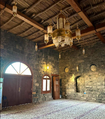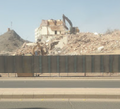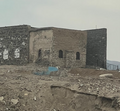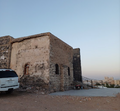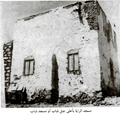Al-Rayah Mosque (Medina)
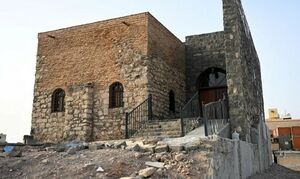 | |
| General Information | |
|---|---|
| Other Names | Dhubab Mosque, Qarin Mosque |
| Place | in the north of Medina on top of Mount Dhubab |
| Usage | Mosque |
| Religious Aspect | |
| Religious Affiliation | Islam |
| Beliefs | Prayer of the Prophet (s) in the area of this mosque |
| Rituals | performing congregational prayers |
| History | |
| Time of Construction | during the time of the prophet |
| Events | Demolition of houses around the mosque at the end of 2023 AD |
| Reconstructions | The last renovation in 2022 |
| Historical Features | The place of the Prophet (s) tent and praying while digging a trench during the Battle of Ahzab |
| Current State | |
| Status | Available |
| Capacity | 100 people |
| Parts | Mihrab and Musalla |
Al-Rāyah Mosque (Arabic: مسجد الرایه) (Means: Flag Mosque), also known as Al-Dhubāb Mosque and Qarin Mosque, is a mosque located in the north of Medina on top of Mount Dhubab.
During the Battle of Ahzab, a tent was erected for the Prophet (s) on top of Mount Dhubab where he prayed. Later, Muslims built the Al-Rayah Mosque to commemorate this place.
Location
Dhubab Mosque is located to the northwest of the Masjid al-nabi[1] It is situated on the small Mount Dhubab, on the right side of Uthman b. Affan Street.[2] This mountain is situated east of the Sal'a mountain and near the Thaniyya Al-Wada area. .[3]
Current Status
The entrance to Al-Rayah Mosque is on the qibla and the south side. [4] The mosque has a simple appearance and does not have any minaret or prominent verses or designs inside or outside. [5] In late 2022, the mosque underwent reconstruction, resulting in a transformation of its appearance from a white color to a more traditional stone-like style. However, by the end of 2023, the surrounding houses have been demolished. [6]
Background
During the Battle of Ahzab (in the fifth year of the Hijra) and while digging the trench around Medina, a tent was set up for the Prophet (s) to provide relief and oversee the excavation work. It was in this tent that the Prophet (s) would perform his prayers.[7]
Names
It appears that the reason for naming this mosque as Masjid al-Rayah (Flag Mosque) is that the flag of the supporters was raised in this location during the Battle of Harrah(63 AH). [8] It is also possible that this name is due to the placement of the flag of Islam on this mountain during the Battle of Khandaq (The Trench).[9] Furthermore, it has been stated that Dhubab was the name of a man who was hanged by Marwan ibn Hakam on top of this mosque. [10] Another name for this mosque is "Qarin Mosque".[11]
History
According to one of evidences, Masjid Al-Rayah was first built during the reign of Umar ibn Abdul Aziz in Medina. [12] The mosque building had been destroyed during a period before the 9th century AH, and around 845 AH/1441-2, it was reconstructed by Amir Janbak al-Nayruzi.[13] In addition, several Saudi historians have seen and described this mosque at different times. Abdul Qudous Ansari (died 1403 AH) saw the mosque in the late 14th century and found that the length and width of the building was 4 meters and the height was 6 meters. Ansari believed that the stone construction of the mosque was similar to its 9th-century construction.[14] Shanqiti (died 1393 AH) also described the mosque as an outdated stone building from 1405. According to him, the mosque has only one main room and a courtyard without doors.[15] Elias Abdul Ghani describes in al-Athriya mosque that the interior and exterior of the building were painted in 1418 AH and had a roofed prayer hall, which extends the space of the mosque, where the five prayers are held.[16] In his book published in 2011, the contemporary researcher Kaki states that the mosque remains the same as described by Ansari. However, Kaki has reported the reconstruction of the mosque during the Al Saud era.[17]
Gallery
Images of the mosque, in 2021 (the time when this white appearance of the mosque came into existence is not specified)
-
The exterior environment of the mosque with white walls and white color scheme
-
Image of the interior environment of the mosque + the mihrab area
-
The public section of the mosque's prayer hall that has been attached to the main section
-
The exterior view of the mosque along with the surrounding houses and the public passage
-
The main and old section of the mosque with dimensions approximately 4 meters in length and width + a view of the ceiling
Images of the mosque after the 2022 renovation
-
Entrance of the mosque
-
The return of the appearance of the mosque's walls and arches to their former and ancient look
-
Public space of the mosque
-
Presence of worshipers in the mosque
-
A view of the mihrab and the main old section of the mosque
Images from 2024, after the demolition of the houses around the mosque
-
Images from a distance of the mosque area during the municipality operations in Medina
-
The back wall of the mosque in the midst of the municipality operations
-
View of the mosque after the demolition of the surrounding houses
-
A distant view of the mosque after the renovation operations where only the mosque building remains
-
The current image of the mosque after leveling the surrounding lands
Old pictures of the mosque building
Notes
- ↑ ʿAbd al-Ghanī, Masājid al-Ātharīyah, p. 80.
- ↑ Kaʿakī, Maʿālim al-Madīnah al-Munawwarah Bayna al-ʿAmārah wa al-Tārīkh, vol. 2, p. 160,164.
- ↑ ʿIyāshī, Al-Riḥlah al-ʿIyāshīyah, vol. 1, p. 396.
- ↑ Kaʿakī, Maʿālim al-Madīnah al-Munawwarah Bayna al-ʿAmārah wa al-Tārīkh, vol. 2, p. 168.
- ↑ Kaʿakī, Maʿālim al-Madīnah al-Munawwarah Bayna al-ʿAmārah wa al-Tārīkh, vol. 2, p. 172.
- ↑ Website of Saudi Press Agency (SPA)
- ↑ Samhūdī, Wafāʾ al-Wafā bi Akhbār Dār al-Muṣṭafá , vol. 3, p. 201.
- ↑ Samhūdī, Wafāʾ al-Wafā bi Akhbār Dār al-Muṣṭafá , vol. 3, p. 204.
- ↑ Shanqīṭī, Al-Durr al-Thamīn fī Maʿālim Dār al-Rasūl al-Amīn , p. 71.
- ↑ Namīrī, "Tārīkh al-Madīnah Munawwarah", p. 262.
- ↑ ʿAbd al-Ghanī, Masājid al-Ātharīyah, p. 80.
- ↑ al-Samhūdī, Wafāʾ al-Wafā bi Akhbār Dār al-Muṣṭafá , vol. 3, p. 202.
- ↑ Anṣārī, Āthār al-Madīnah al-Munawwarah, p. 129.
- ↑ Anṣārī, Āthār al-Madīnah al-Munawwarah, p. 129.
- ↑ Shanqīṭī, Al-Durr al-Thamīn fī Maʿālim Dār al-Rasūl al-Amīn , p. 172.
- ↑ ʿAbd al-Ghanī, Masājid al-Ātharīyah, p. 80.
- ↑ Kaʿakī, Maʿālim al-Madīnah al-Munawwarah Bayna al-ʿAmārah wa al-Tārīkh, vol. 2, p. 166.
References
- ʿAbdu-l Ghanī, Muḥammad ʾIlyās. Al-Masājid al-Atharīyya fī al- madīna al-munawwara. Medina: [n.p], 2000.
- Anṣārī, ʿAbdu-l quddūs al-. Āthār al-madīna al-munawwara. Medina: Maktabat al-Salafīyya, 1973.
- ʿAyyāshī, ʿAbd Allāh b. Muḥammad. Al-Riḥla al-ʿAyyāshiyya. Abu Dhabi: Dār al-Suwaydī, 2006.
- Kaʿakī, ʿAbd al-ʿAzīz al-. Al-Majmūʿah al-Muṣawwarah li-Āshar al-Maʿālim al-Madīnah al-Munawwarah. Medina: 1999
- Kaʿakī, ʿAbd al-ʿAzīz b. ʿAbd al-Raḥmān. Ma ʿālim al-madina al-munawwara bayn al-ʿMārat wa al-Tārīkh. Beirut: Dār wa maktabat al-hilāl, 2011.
- Khiyārī, Sayyraid Aḥmad Yāsīn. Tārīkh maʿālimal-madīna al-munawwara qadīman wa ḥadīthan. Riyadh: al-Amāna alʿāmma li-liḥtifāl miʾat ʿām ʿalā tʾsīs al-mamlika al- ʿarabiyya al-suʿūdiyya, 1419 AH/1999.
- Numīrī, Ibn Shabbah. Tārīkh al-madīna al-munawwara. Edited by Fahīm Muḥammad Shaltūt. Tehran: Mashʿar, 1380 sh.
- Samhūdī, ʿAlī b. ʿAbd Allāh. Wafāʾ al-wafā bi akhbār dar al-Muṣṭafā. Edited by Muḥammad Muḥyi al-Dīn ʿAbd al-Ḥamīd. Beirut: 1984.
- Shanqīṭī, Ghālī Muḥammad Amīn al-. Al-Durr al-Thamīn fī Maʿālim Dār al-Rasūl al-Amīn. Jeddah: Dār al-Qiblah, 1992.







